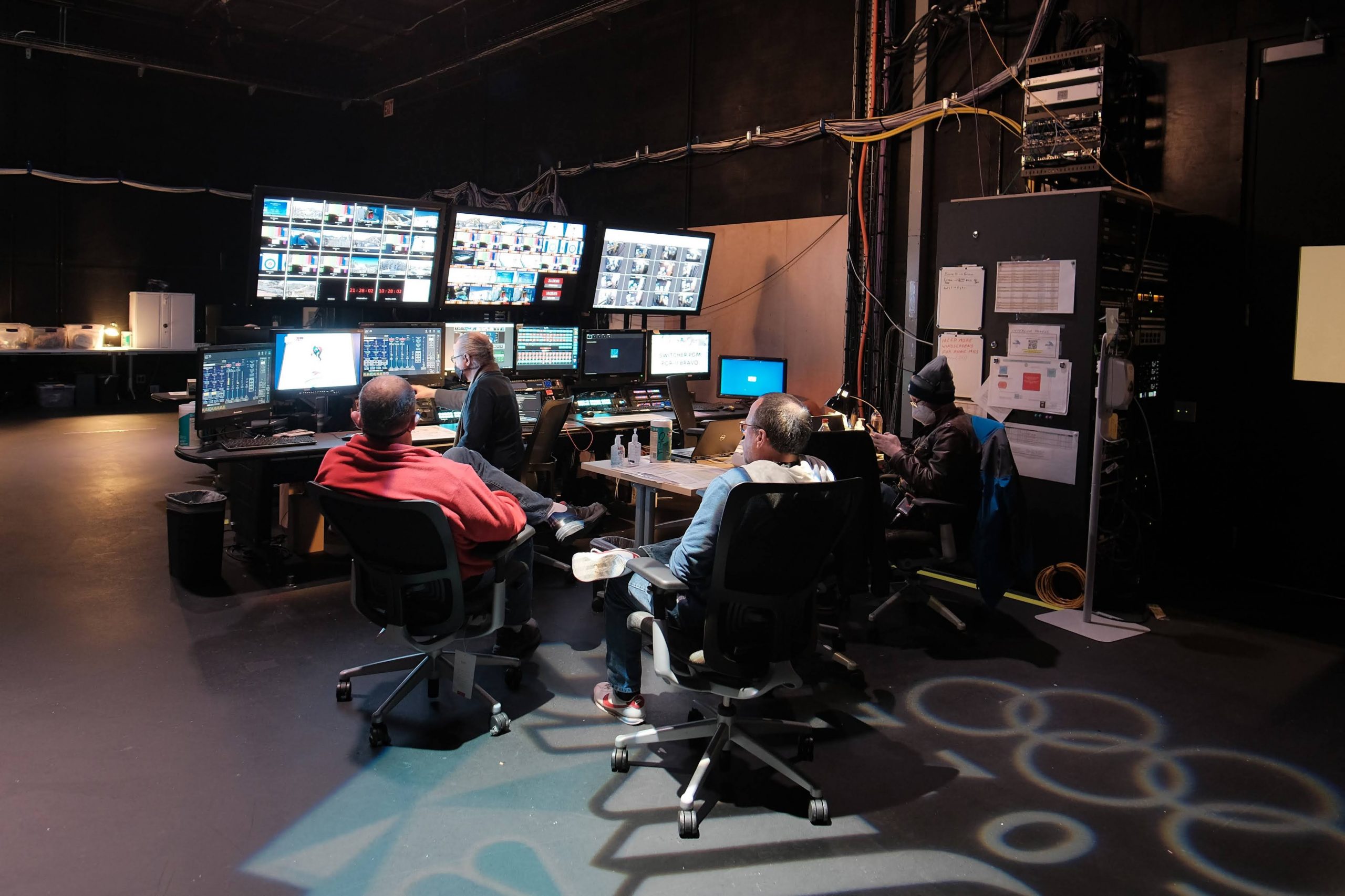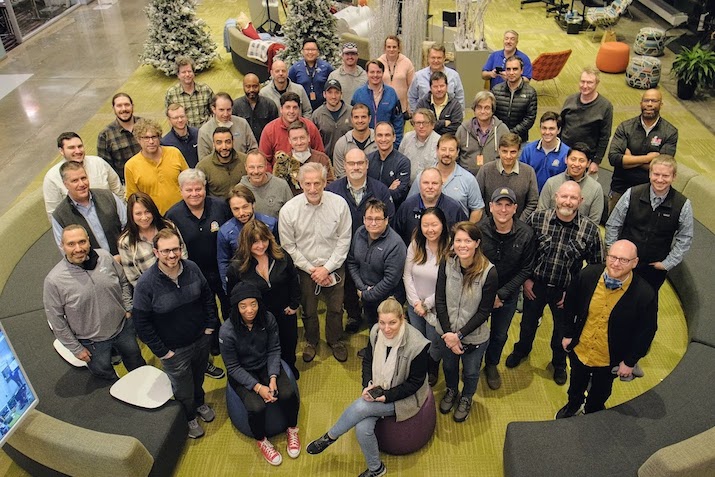Beijing 2022: NBC Olympics’ Dave Mazza on Producing Primetime in Stamford, the Challenges of 1080p HDR, and Navigating the Pandemic
The at-home operation is bigger – and more complex – than ever for the Beijing Games
Since joining NBC prior to the 1996 Atlanta Games, NBC Olympics SVP/CTO Dave Mazza has seen it all over the course of 13 Olympic Games with the Peacock (17 in his career). But he has been floored by the challenges his team has faced in broadcasting the 2022 Beijing Winter Games and is experiencing the Olympics in a whole new way.
For one, this marks the first time in Mazza’s Olympics career that he isn’t onsite in the host city overseeing the broadcaster’s gargantuan operation at the International Broadcast Centre. Instead, he’s at NBC’s Sports Production Operations Center (SPOC) in Stamford, CT – along with 1,500 other NBC staffers. In fact, because of China’s extensive COVID-mandated closed loop, the majority of NBC’s Beijing 2022 production is being handled remotely in Stamford with a much-reduced crew of roughly 600 onsite in China.
SVG sat down with Mazza to examine the operations in both Stamford and Beijing and how they are different from those of every other Games he has been a part of. He also discusses how his team managed the ultra-quick turnaround from the 2020 Tokyo Summer Games last summer, the introduction of 1080p HDR workflows into the Stamford plant, the previously unthinkable task of producing NBC’s Olympics 2022 Primetime show remotely, the effect of having all NBC commentators announce the action remotely, and how he and his team have maintained their sanity during one of the most treacherous stretches in live-production history.
First, let’s go back to Tokyo. How did your team deal with the turnaround of just six months heading into the Beijing Games?
Everything was constantly changing and moving right up through Opening Ceremony.
Two days before Closing Ceremony in Tokyo was when we decided to move the Primetime control room home [to Stamford instead of Beijing]. We were two days away from starting to tear down, and we had to act quickly to divert a bunch of [equipment] that we needed for conversion to do HDR in Stamford. We pulled a bunch of stuff out of the racks that would’ve been headed for China and sent it instead to Stamford — monitors, scopes, and various things we needed for HDR that we didn’t have in Stamford yet. Everything else shipped to Beijing. Then, [VP, Engineering,] Tim Canary’s and [VP, Post Production and Digital Workflow,] Darryl Jefferson’s teams had to very quickly convert PCR-2 [in Stamford] and bunch of Edits and Ingest channels to be able to do the Primetime show in HDR.
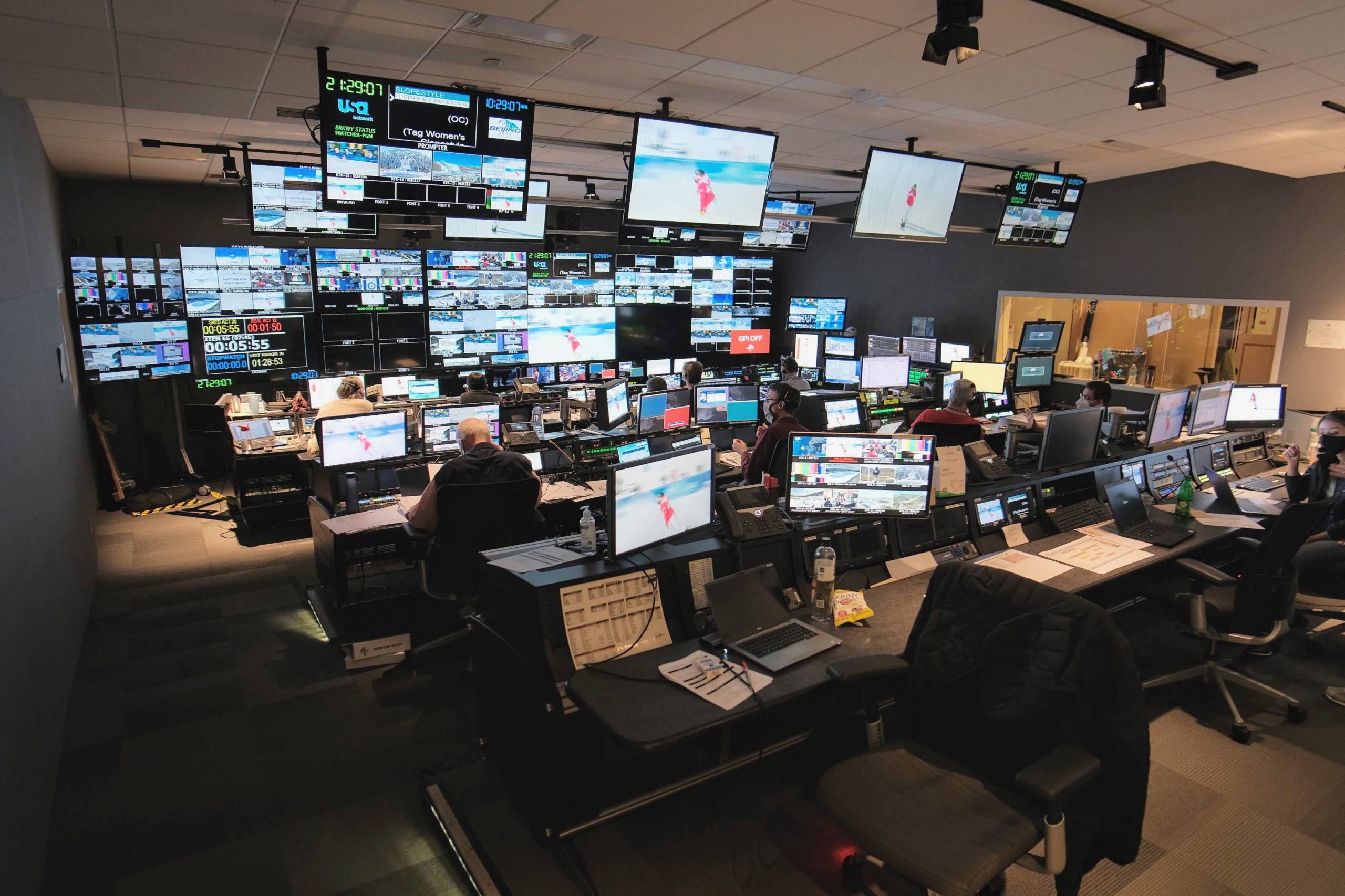
NBC had to quickly convert its PCR-2 in Stamford, as well as edit systems and ingest channels to be able to do the Primetime show in HDR.
Speaking of HDR, can you detail what was required in Stamford to make that transition to 1080p HDR for the Beijing Games?
Anytime we have made any kind of [engineering] refresh changes over the last three years in Stamford, we have been installing 3G and 1080p HDR-ready gear, as we knew we’d be switching over to HDR [in the future]. However, any changeover was further out on our roadmap. So it was still a big lift to get everything configured and tested in time for the Primetime show. Add to that, the SPOC team was still getting their new IP router to settle down.
During Tokyo, the big lift was at all the venues for [NBC Olympics VP, Venue Engineering,] Chip Adams and his team and all of the OBS team, who had to get going in 4K HDR and 1080p HDR for the first time ever at an Olympic scale. HDR in the Tokyo IBC was more straightforward, because the whole of the NBC IBC pretty much ran in HDR. We had two flavors [HDR and SDR] floating around in the new Grass Valley IP router, but most of the SDR was headed home to Stamford, which had almost all SDR for the cable shows. The only exception was the trucks we pulled up to the building for Golf and Beach Volleyball, which were doing HDR, but those feeds were contained in the truck. So Stamford didn’t have much HDR in the building.
When the shift home was made for Beijing, nearly all of the over 200 feeds coming into Stamford had to have an SDR and HDR copy because we have to make both copies available for the different rooms. PCR-2 is running in HDR with five or six EVS [servers] and about 10 out of 55 edits running in HDR, but all the other PCRs and Edit rooms are running SDR. And keep in mind, all those rooms are running in 50 Hz as well — with the exception of PCR-8, which is in 60 Hz because it’s handling Golf [Channel]. It was quite a challenge to get that all squared away in a plant that was also on the air with all of our regular sports programming. PCR-2 was also upgraded to handle the 5.1.4 immersive-audio mix for [Dolby] Atmos and all 16 channels of audio in the venue-generated 1080p HDR feeds to allow for that.
Another thing we were lucky with in Tokyo was, we had to train only a small group on HDR. But, in Stamford, it was a much bigger group to train, and we had a lot less time to do it. Getting people to recognize the wrong source from the right source is not easy, especially when it’s a file [in which the only difference is] SDR vs. HDR levels. If a mistake is made, chances are, you may not notice it until pretty far downstream, and then you have to backtrack and do the forensics to figure out where it happened and how to correct it for next time. That has been a learning experience for everybody here in the plant.
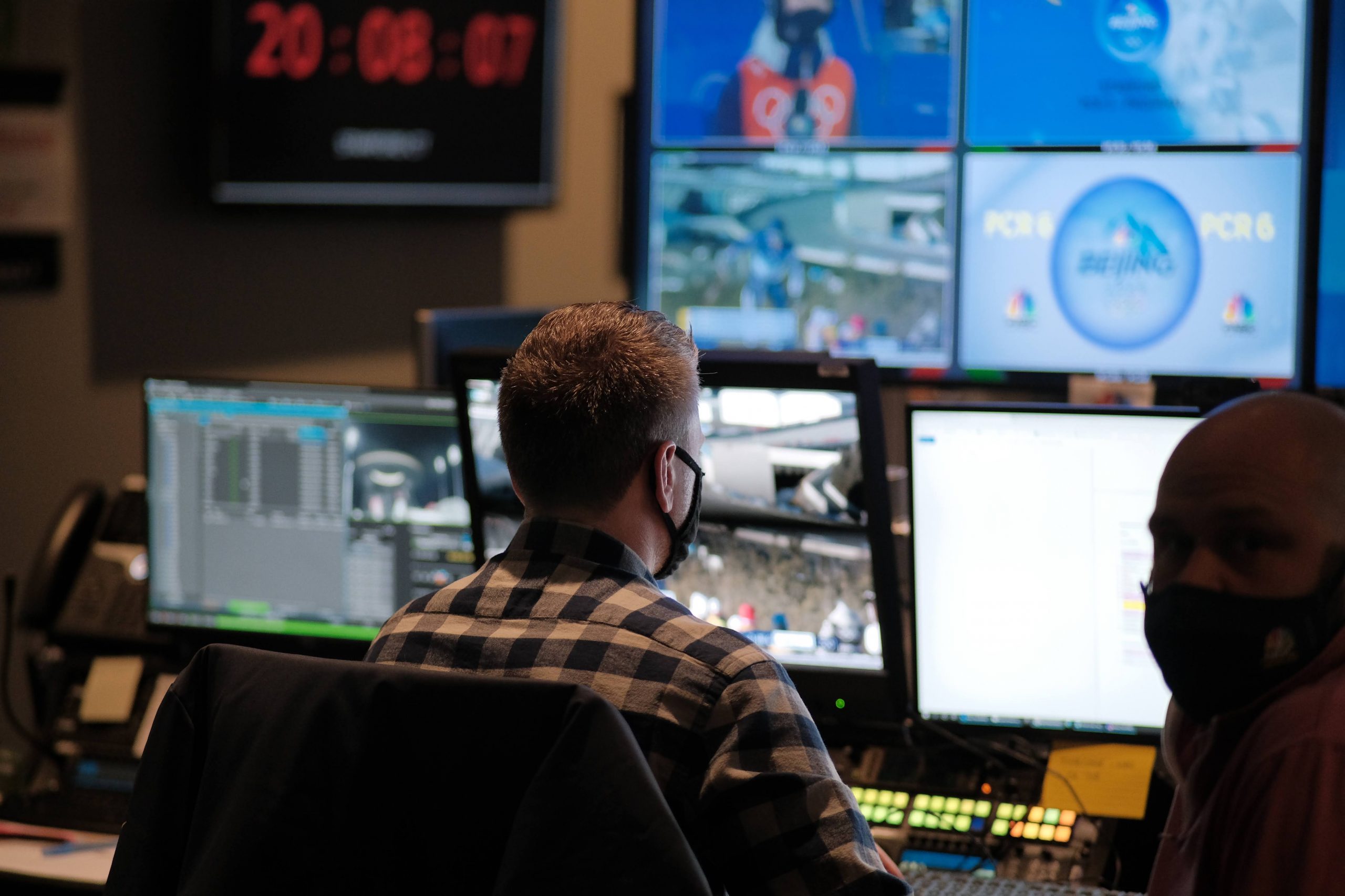
In addition to having to integrate 1080p HDR technology and workflows into the Stamford facility on a short timeline, NBC also had to train the entire at-home crew.
Would you say the shift to 1080 HDR has been the biggest change for the operation in Stamford compared with Tokyo? And, if not, what would be the biggest?
Well, certainly HDR was quite a challenge, but I’d have to say having the Primetime show here was the biggest. You can imagine it has much greater production needs than anything else we do, and it requires more [resources]. Most of the cable dayparts primarily use world-feed coverage, a mixed-zone camera or two, plus our announcers, but Primetime just has so many accoutrements. It was a big thing to get all of those pieces in place here for the Primetime show, especially when so many of them are coming from China and all the limitations of movement caused by the pandemic protocols. I should point out that we could not have taken on all this added complexity without the steady leadership of our Coordinating Director Mike Sheehan. He not only coordinated every bit of the production plan but also knows how to push us all to excel, without pushing us over the edge.
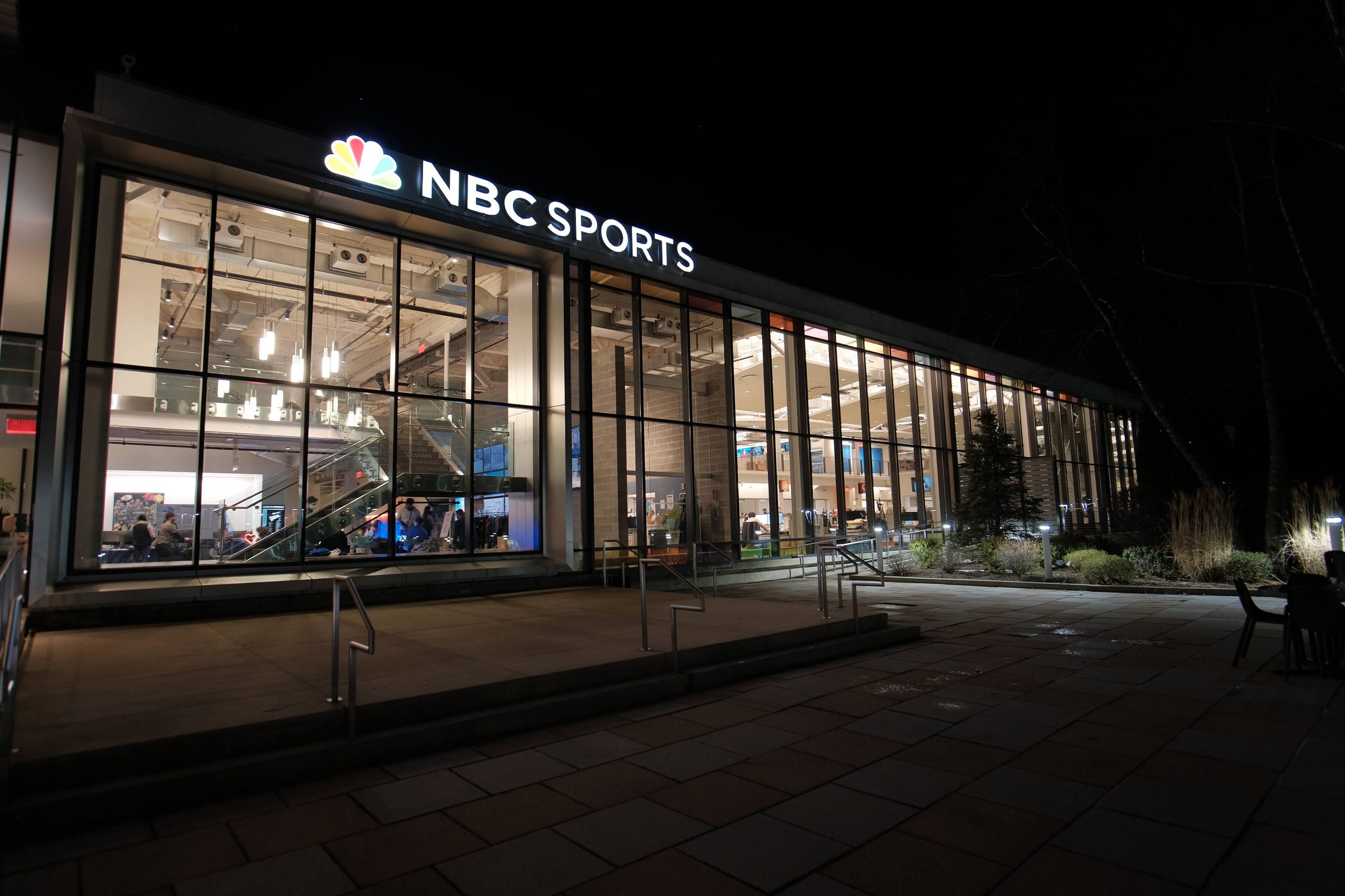
NBC’s Sports Production Operations Center in Stamford, CT, serves as the primary hub for its Beijing 2022 coverage this year.
You also have four mobile units pulled up to the dock here in Stamford. What role are they playing in NBC Olympics’ operations?
That has been another big change. We have four full venue coverage trucks here at the dock. Even though we had five remote venue controls for Tokyo — for Golf, Beach Volleyball, Basketball, Indoor Volleyball, and Sky Sports — they were almost totally self-contained. But this time, at the dock, we have trucks doing the Opening and Closing Ceremonies, the Alpine [venue], half of the Extreme venue, Long Track Speed Skating, and Sliding. And one of our small Simply Live control rooms is doing Short Track. All of those venues hit the Primetime show and utilize various studios and elements in SPOC, so they were much more complex this time.
Inside SPOC, we also had a lot more facilities and moving pieces. In all, for [Beijing 2022], we have nine control rooms [four trucks and five PCRs], plus another three control rooms for Golf [Channel] operating here.
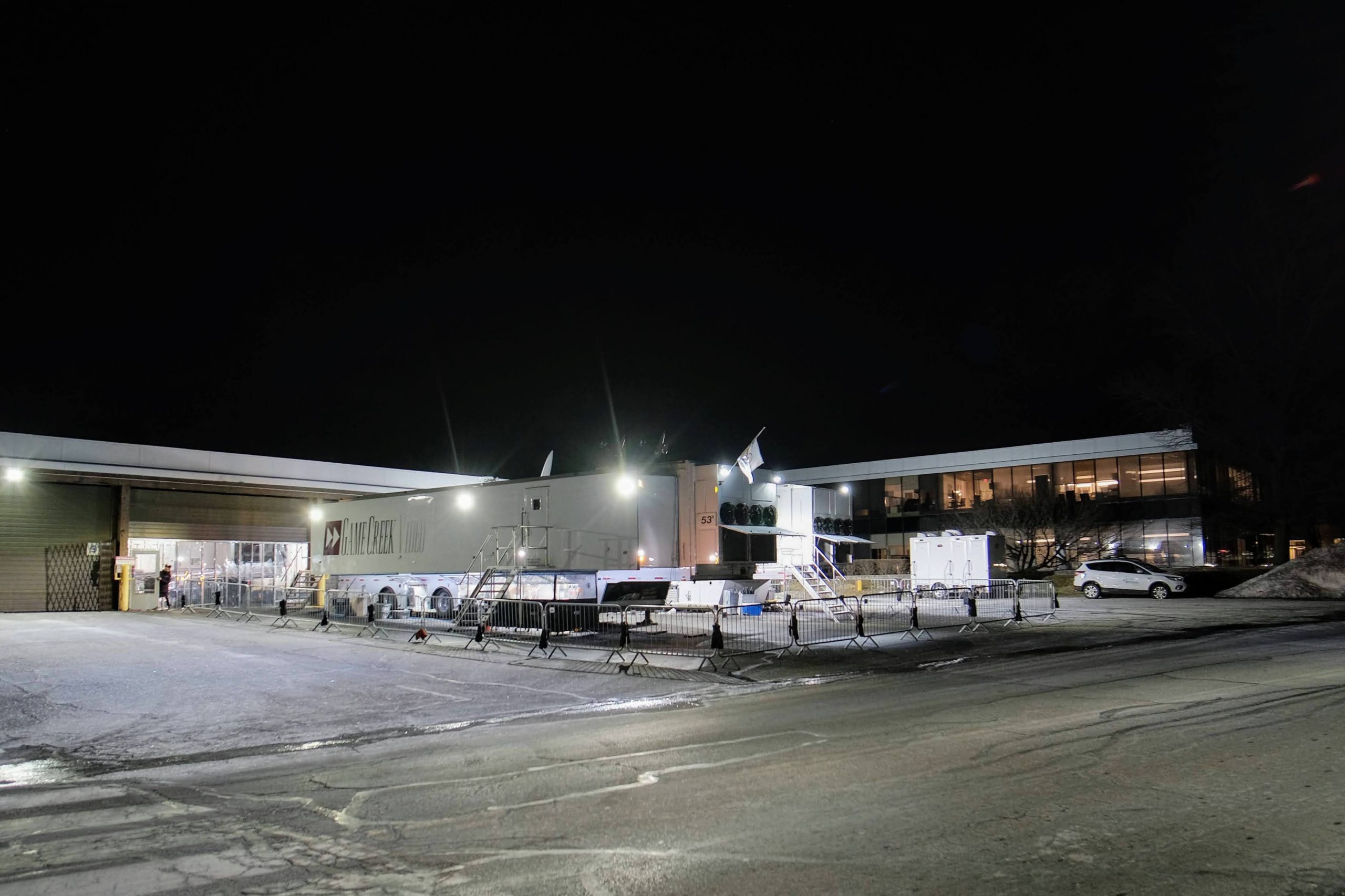
NBC has pulled up four full venue coverage trucks at the dock to handle the increased volume of production happening in Stamford.
With nearly all your on-air talent at home in Stamford this year, how has the Off-Tube Factory remote commentary operation expanded?
Thankfully, there’s only about half as many sports in a Winter Games as in a Summer, so we’re good on the booth count, but there are a few changes there.
First, all the booths now have a 1080p HDR path in addition to the 1080i SDR path. In addition to that, we had to modify the booths to handle some of the Friends & Family feeds spy cams, and a new mix minus router that [NBC Sports Group Director, Broadcast Communications] John Pastore and his team commissioned between Games. The comms team also managed what we think was probably the world’s largest trunked intercom system to date.
How did the late decision not to send commentators to Beijing impact the operation in Stamford?
That was a big challenge because the decision was made to move the A-venue announcers to Stamford weeks out from the Games. That [comprised] our announcers for Figure Skating, Alpine, Extreme, and Short Track [Speed Skating]; our Hockey announcers had already been pulled back home. Many of them are now in announce booths, and that is pretty straightforward and similar to what we’ve done in the past. But others are calling events from various studios [in Stamford] back to the venues in China.
The Figure Skating announcers, for example, are here in Studio 2. Johnny [Weir], Tara [Lipinski], and Terry Gannon are sitting in our studio calling the Figure Skating. They can go on camera, but everything they do — including their on-cameras and their voices — goes back to China to get put into the [Figure Skating] truck at the venue. We were expecting [our announcers] to be in Beijing, and, when the last-minute change was made, we didn’t have the [capacity] to light up another control room to mix them here in Stamford.
Essentially, when they’re calling the Figure Skating, pictures and sound go under the Pacific three different times: the truck output comes here from Beijing; their [provided commentary] and their voices go back to Beijing on MADI, where they get mixed into the show by the [A1 in the Figure Skating truck]; and finally, the program output comes back here, and that’s what goes on-air. It’s three trips under the Pacific, which is a little over 20,000 miles, and we’ve got it down to only ¾ of a second for three of the trips.
On top of that, some of these announcers weren’t able to travel to Stamford, and [their commentary comes] into our remote commentary system via their home internet and cellular modems as a backup. This system was created during the pandemic and utilizes Tieline ViAs to connect the announcers to SPOC.
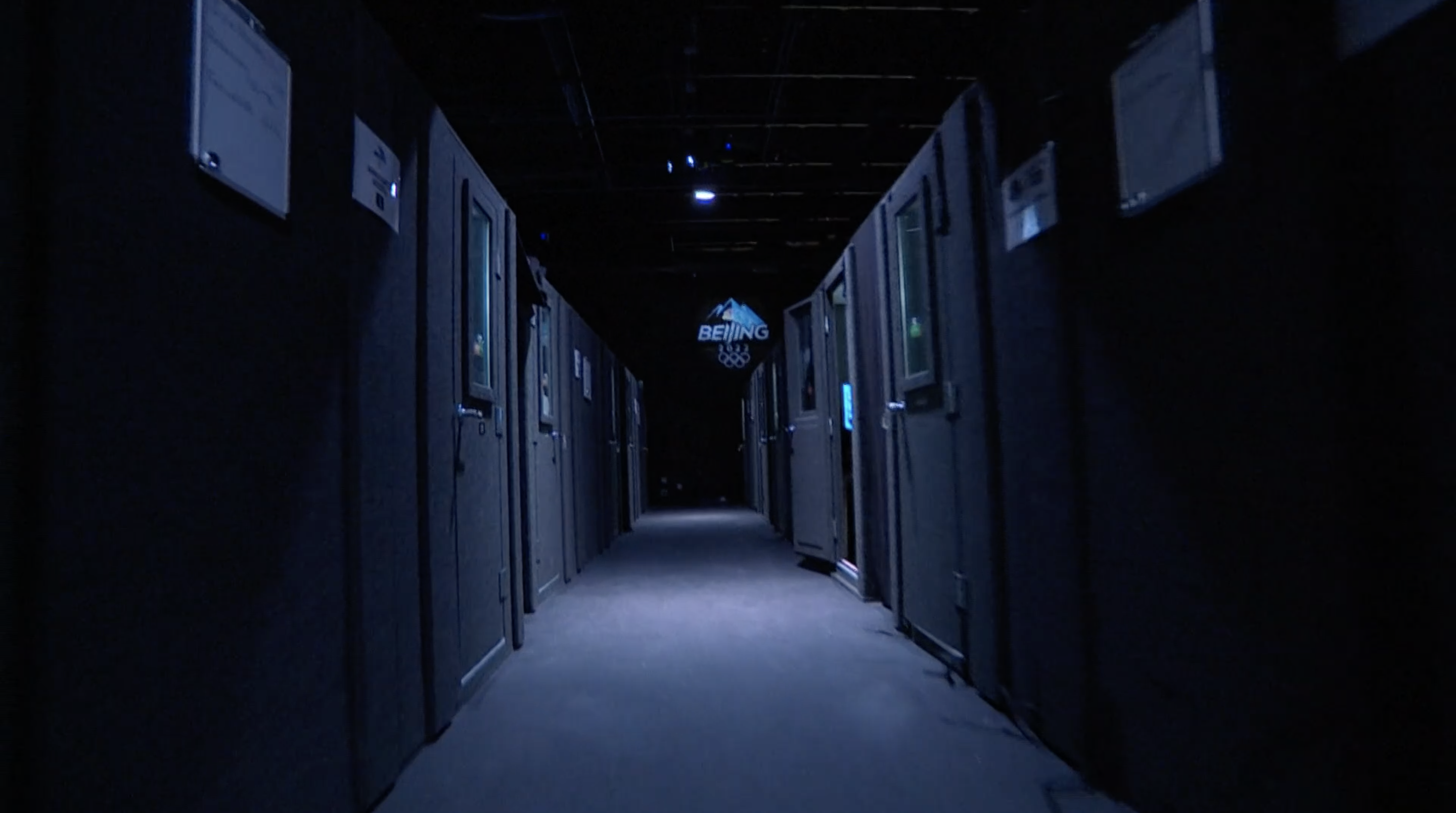
NBC’s Off-Tube Factory is back for another Games, with nearly all announcers providing commentary remotely from Stamford.
How has having such a large operation in Stamford affected your setup at the venues in Beijing?
It has really impacted [our plans] across all the venues. However, Chip Adams and his team were able to achieve our original production goals at our four biggest production venues: Figure Skating, Extreme, Alpine, and Ceremonies. Figure Skating, which is on a flypack from NEP Singapore didn’t cut back anything. They have a bunch of [Sony HDC-4800] SSM cameras that we added to be able to do more analysis on the Figure Skating coverage. Chip’s team also set up an NBC flypack for the Ceremonies coverage that fed 32 HDR cameras and OBS splits back to the Opening truck at the SPOC dock, and another 20 feeds from inside SPOC fed that control room. That truck then flipped over to become the Sliding control room.
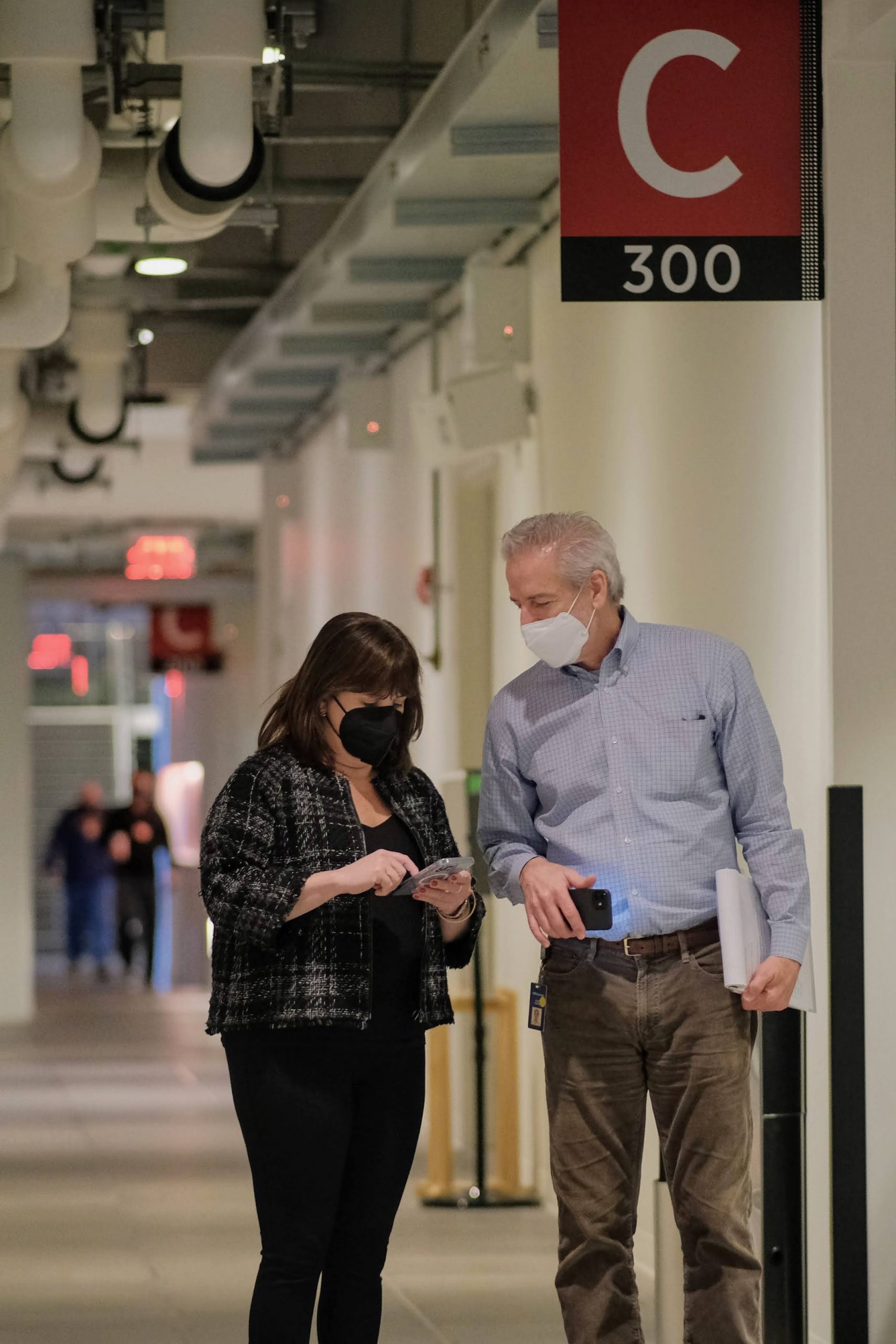
NBC Olympics SVP/CTO Dave Mazza (at right conversing with Rebecca Chatman, VP and Coordinating Producer, Olympics) is located in Stamford – rather than on-site at the IBC – for the first time in his 13 Olympics with NBC (and 17th overall).
We had planned to have two Game Creek trucks at Extreme, and, before the second one shipped, we cut that back, again to reduce people in country. We have one truck [at the venue] and another here at the dock for Extreme. We don’t think the viewer could detect that.
We have another one of our own flypacks up at the Alpine Center, and that sends home 20 feeds to a control truck here in SPOC. That flypack also has three Simply Live servers that we’re remotely controlling from the Alpine truck here at the truck dock.
All of these workflows are quite complicated in and amongst themselves in addition to the aggregate.
Outside of those four big venues, we have all the smaller venues, where we have either a small NBC flypack or just a mixed-zone camera for the interviews and one other feed home that is either a headhunter camera to shoot athletes or a wide shot from OBS to help with a bridge shot to go to and come back from commercial.
Of course, we were challenged for crew everywhere because it was so difficult to get people into the country and into position. Absolutely everybody in China has pitched in, no matter what their original job was, in order to pull this off. [VP, Olympic Operations] Marsha Bird and [VP, Olympic Operations] Ryan Soucy led the operational and logistic charge in China to get that all to work. All their teams have done an incredible job in doing so. On top of all that, our President Gary Zenkel has been there throughout all of this pushing to help all of our staff navigate the everchanging COVID protocols, among all his other duties.
How has your presence at the IBC in Beijing changed for these Games?
The IBC [buildout] was obviously very fast-moving. In some cases, it was easier to just keep building what you were planning on building, so you didn’t have to modify all of the pieces and instead just used less of them.
At the IBC, [VP, Engineering Technology,] Todd Donovan’s and [VP, Production Operations] Atila Ozkaplan’s talented teams went ahead and built the Primetime studio because [Primetime anchor] Mike Tirico was going to be over there. It’s a beautiful, warm-looking chalet-like studio. Craig Melvin and Maria Taylor were also using that studio. But they’re all home now after Super Bowl. In addition to that Primetime studio, we also have a Studio B and a Studio C that do smaller interviews with athletes. That [studio plan] pretty much stayed the same, but it has a whole lot less traffic going through it than expected.
The IBC [footprint] looks a lot like what we had planned because it was mostly built when we made the decision to move things to Stamford. But Todd’s team still needed to install much of the same gear in order to receive and pass on all the feeds to Stamford. This involved modifying the original plan so we could operate with less crew but still reliably receive the feeds, QC them, and send them home, along with the cameras from the studios.

More than 1500 staff are on hand in Stamford (seen here), while a reduced crew of roughly 600 are in Beijing.
How has the transmission scheme changed with so many feeds coming back to Stamford?
The transmission area at the IBC is about half the size of [that for] a normal Games. [VP, Transmission Operations and Engineering,] Chris Connolly’s transmission team decided that with so many of the control rooms being here [in Stamford], they decided to only pass the venue signals through the IBC — as they needed to get on the big AT&T circuits coming home — but they weren’t decoded [at the IBC]. [An example] is the 32 feeds that came home for Opening Ceremony: none of them got decoded in the IBC because no one there needed them. Same goes for the 20 feeds coming over from Alpine, the eight from Speed Skating, the eight from Extreme, and the eight from Sliding. They all pass through the IBC un-decoded and land in a MediaLinks frame [in Stamford] that’s right out at the truck dock, and it delivers those feeds directly to the trucks. No one in the plant can get at the 32 feeds from the Opening Ceremony because they weren’t needed since the truck was handling that. The truck’s output is what comes back into the Stamford router.
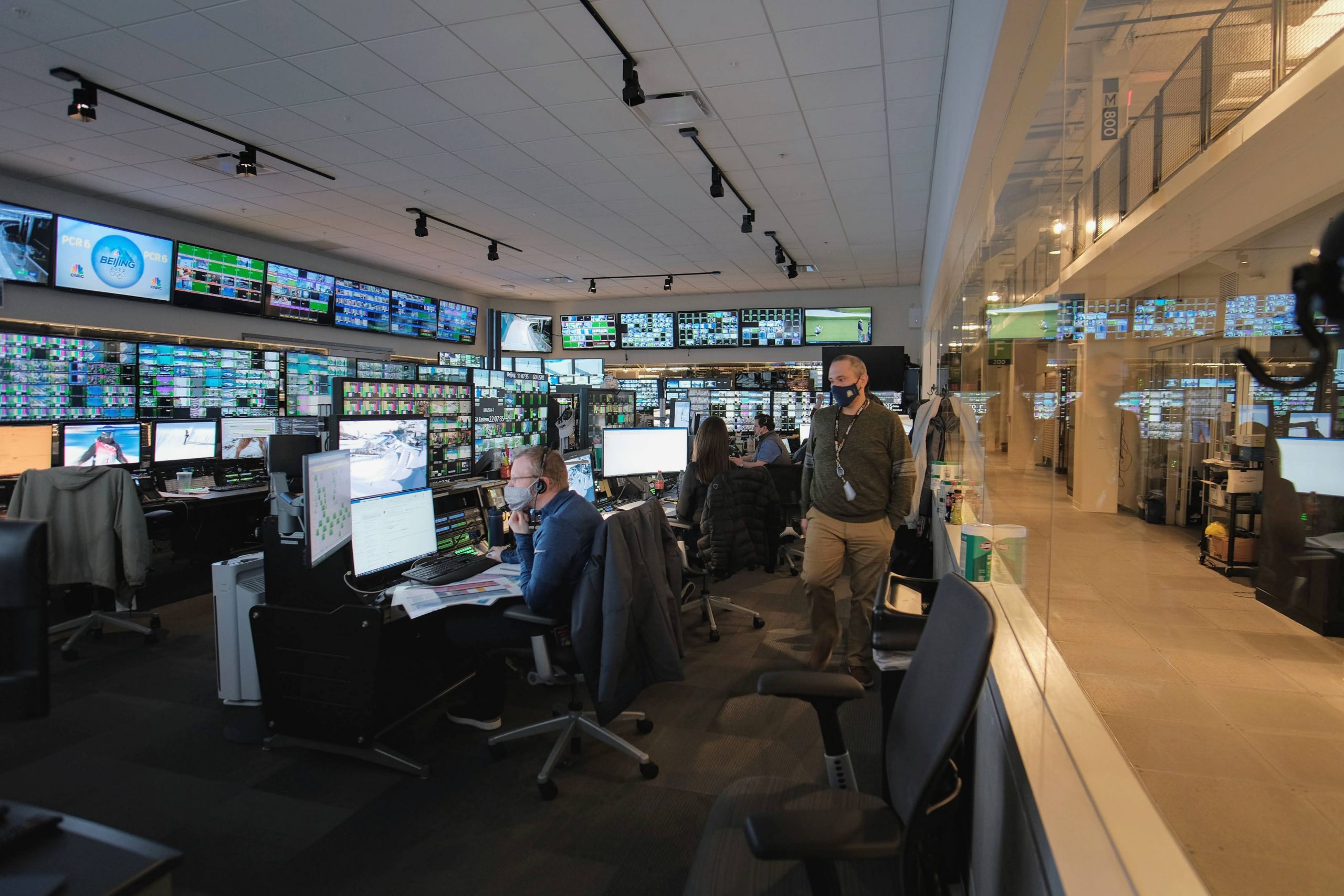
The Broadcast Operations Center (BOC) is one of the core areas in NBC Sports’ Olympics efforts in Stamford and helps to monitor the ultra-complex signal transmission for the Games.
Who are some of the key technology vendors and partners that have played a role in NBC Olympics’ Beijing 2022 operation?
We are supported by a plethora of vendors for the Olympics. Sony, Canon, and Cisco continue to big our biggest partners. In addition, some of our key technology partners include NEP, GCV, LMG/Harb, BroadcastRF, AT&T, RTS, ACS, Grass Valley, Avid, Calrec, EVS, Chyron, MediaKind, Planar, Telestream, LiveU, Haivision, Bexel, Harmonic, Audio-Technica, Linear Acoustics, Ross, TAG, SMT, Simply Live, VizRT, EMC, Fingerworks, Dartfish, Rawmotion, Signiant, Lawo, Cue Script, Anton Bauer, Evertz, BBright, Cromorama, Dolby, EEG, VITAC, and Comcast Business.
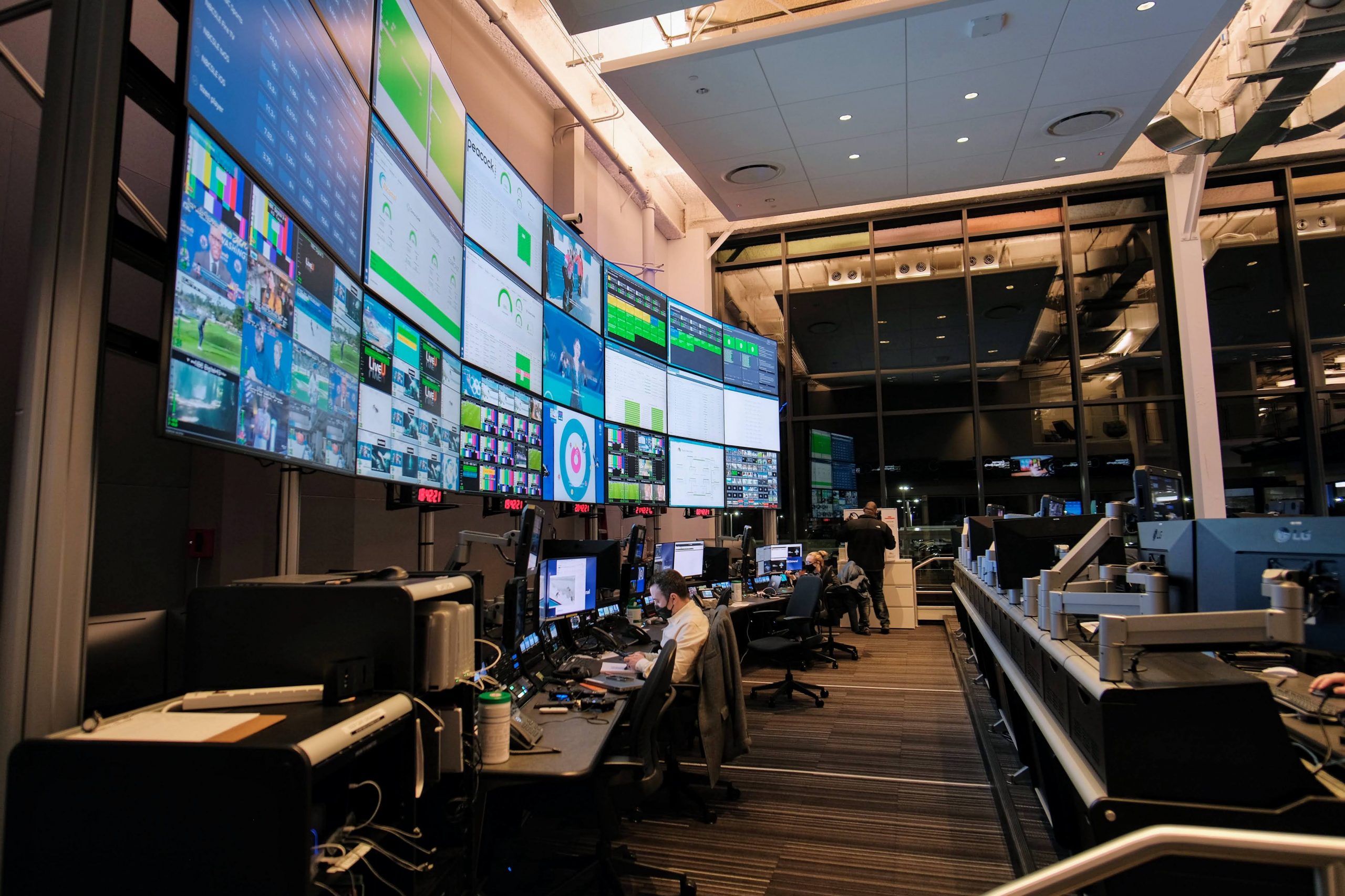
After debuting in Stamford last year for the Tokyo Games, NBC has brought back the digital network operations center to help power Peacock and NBC’s other streaming needs.
Looking back, how much of an added challenge was created by the pandemic, plus the Super Bowl LVI production? Where does this rank among the hardest Games you’ve been a part of?
I like to say that we thought Tokyo was the hardest Games we had ever done, but this is at least three times, if not five times, more complex and challenging. That is mostly due to the COVID protocols [in China].
There was a big ripple effect from the COVID protocols. That caused those venue trucks to be in Stamford. It caused the Primetime control to come to Stamford, which then caused the HDR to come to Stamford. We also had the changing nature of this whole [pandemic] when Omicron started to hit and everything was changing on a daily basis.
But everybody has handled it incredibly and been able to adjust on the fly. Rather than complaining, everybody just found new ways to get the job done. The level of professionalism and great attitudes under extreme conditions — especially for the staff in China — was, and still is, extraordinary.
The teamwork between the two plants, all the venues, and the Super Bowl compound has been amazing. We had to split up all of our talented experts across those locations. Even with thousands of miles between them, it has been a huge coordinated team effort. All of us at NBC are incredibly grateful to everyone who worked so hard to successfully bring both the Olympics and the Super Bowl coverage to our viewers.
This interview has been edited for length and clarity. All photos courtesy of NBC Sports Group/Mike Moutopolous, NBC Sports Integration


